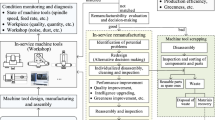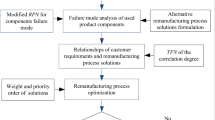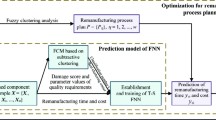Abstract
The remanufacturing of machine tools is a complex approach to regain the original identity, accuracy, and precision of faulty machine tools in order to save time, money, and natural resources. Despite its great importance, the process is not yet fully standardized, and every industry has its own policy to remanufacture their machine tools. This may be due to the fact that machine tools remanufacturing is a stochastic process and problems are mostly related to decision making, and there is no optimized methodology to deal with such problems. Our research is aimed at finding an optimal strategy for remanufacturing decision making problems to make this process more efficient and sustainable. A case study is presented, and information about a test problem is collected based on machine tools remanufacturing knowledge. Decisions are made and the data is organized in a quality function deployment matrix. Analytical hierarchy process and fuzzy linear regression technique are used to quantify statistical data in order to make QFD more practical. Fuzzy relations among QFD data are calculated, and a weighted distance metric is used to find the best solution. Considering the cost of remanufacturing a fuzzy parameter, separate cost-benefit analysis is done to control the cash flow.
Similar content being viewed by others
Abbreviations
- AHP:
-
Analytical hierarchy process
- ROs:
-
Remanufacturing objectives
- RCs:
-
Remanufacturing engineering characteristics
- OEM:
-
Original equipment manufacturer
- DM:
-
Decision making
- QFD:
-
Quality function deployment
- FLR:
-
Fuzzy linear regression
References
Lund, R. T., “Remanufacturing, United States Experience and Implications for Develo** Nations,” Center for Policy Alternatives, Massachusetts Institute of Technology, 1983.
Du, Y., Cao, H., Liu, F., Li, C., and Chen, X., “An Integrated Method for Evaluating the Remanufacturability of Used Machine Tool,” Journal of Cleaner Production, Vol. 20, No. 1, pp. 82–91, 2012.
Du, Y. and Li, C., “Implementing Energy-Saving and Environmental-Benign Paradigm: Machine Tool Remanufacturing by OEMs in China,” Journal of Cleaner Production, Vol. 66, pp. 272–279, 2014.
Aronson, R. B., “Remanufactured Machine Tools,” Manufacturing Engineering, Vol. 131, No. 6, pp. 75–80, 2003.
Jeffrey, O., James, J. C., Michael, F., Jeffrey, D. C., David, A., et al., “Essentials of Business Analytics,” Cengage Learning, Inc., 2014.
Sener, Z. and Karsak, E. E., “A Decision Model for Setting Target Levels in Software Quality Function Deployment to Respond to Rapidly Changing Customer Needs,” Concurrent Engineering, Paper No. 1063293X11435344, 2012.
Yang, Z. and Chen, Y., “Fuzzy Optimization Modeling Approach for QFD-Based New Product Design,” Journal of Industrial Engineering, Vol. 2014, Article ID: 548271, 2014.
Jiang, Z., Fan, Z., Sutherland, J. W., Zhang, H., and Zhang, X., “Development of an Optimal Method for Remanufacturing Process Plan Selection,” The International Journal of Advanced Manufacturing Technology, Vol. 72, No. 9–12, pp. 1551–1558, 2014.
Kim, K.-J., Moskowitz, H., Dhingra, A., and Evans, G., “Fuzzy Multicriteria Models for Quality Function Deployment,” European Journal of Operational Research, Vol. 121, No. 3, pp. 504–518, 2000.
Asai, H. T. -S. U. -K., “Linear Regression Analysis with Fuzzy Model,” IEEE Transactions on Systems, Man and Cybernetics, Vol. 12, No. 6, pp. 903–907, 1982.
Tanaka, H. and Watada, J., “Possibilistic Linear Systems and Their Application to the Linear Regression Model,” Fuzzy Sets and Systems, Vol. 27, No. 3, pp. 275–289, 1988.
Moskowitz, H. and Kim, K., “On Assessing the H Value in Fuzzy Linear Regression,” Fuzzy Sets and Systems, Vol. 58, No. 3, pp. 303–327, 1993.
Saaty, T. L., “How to Make a Decision: The Analytic Hierarchy Process,” European Journal of Operational Research, Vol. 48, No. 1, pp. 9–26, 1990.
Alptekin, S. E. and Karsak, E. E., “An Integrated Decision Framework for Evaluating and Selecting E-Learning Products,” Applied Soft Computing, Vol. 11, No. 3, pp. 2990–2998, 2011.
Shan, Z., Qin, S., Liu, Q., and Liu, F., “Key Manufacturing Technology & Equipment for Energy Saving and Emissions Reduction in Mechanical Equipment Industry,” Int. J. Precis. Eng. Manuf., Vol. 13, No. 7, pp. 1095–1100, 2012.
Author information
Authors and Affiliations
Corresponding author
Rights and permissions
About this article
Cite this article
Ullah, S.M.S., Muhammad, I. & Ko, T.J. Optimal strategy to deal with decision making problems in machine tools remanufacturing. Int. J. of Precis. Eng. and Manuf.-Green Tech. 3, 19–26 (2016). https://doi.org/10.1007/s40684-016-0003-9
Received:
Revised:
Accepted:
Published:
Issue Date:
DOI: https://doi.org/10.1007/s40684-016-0003-9




